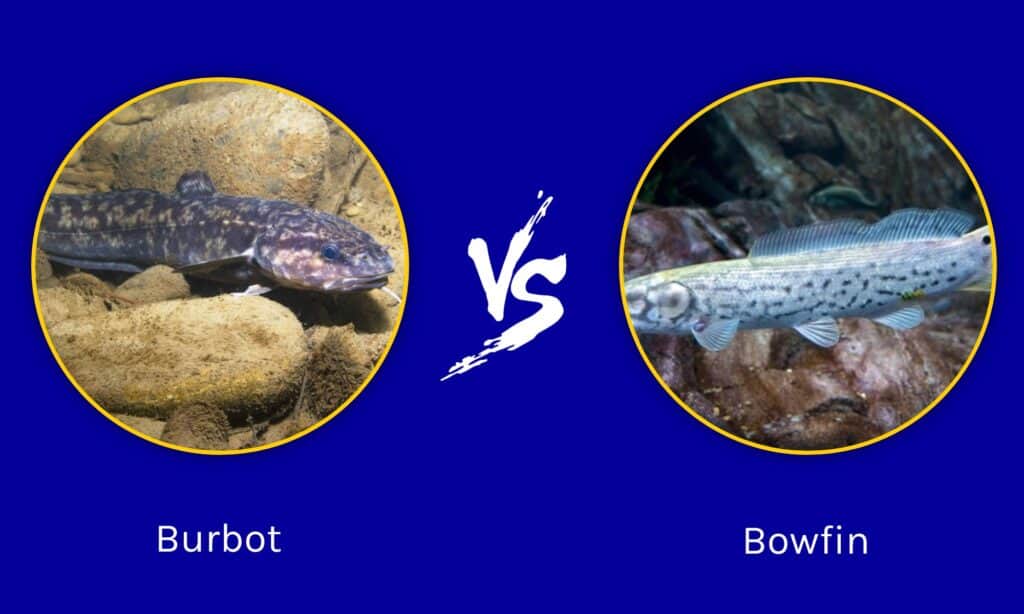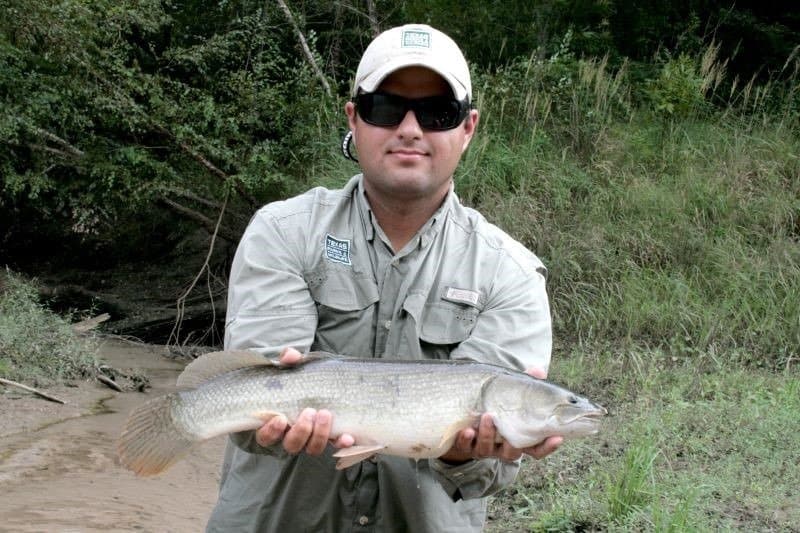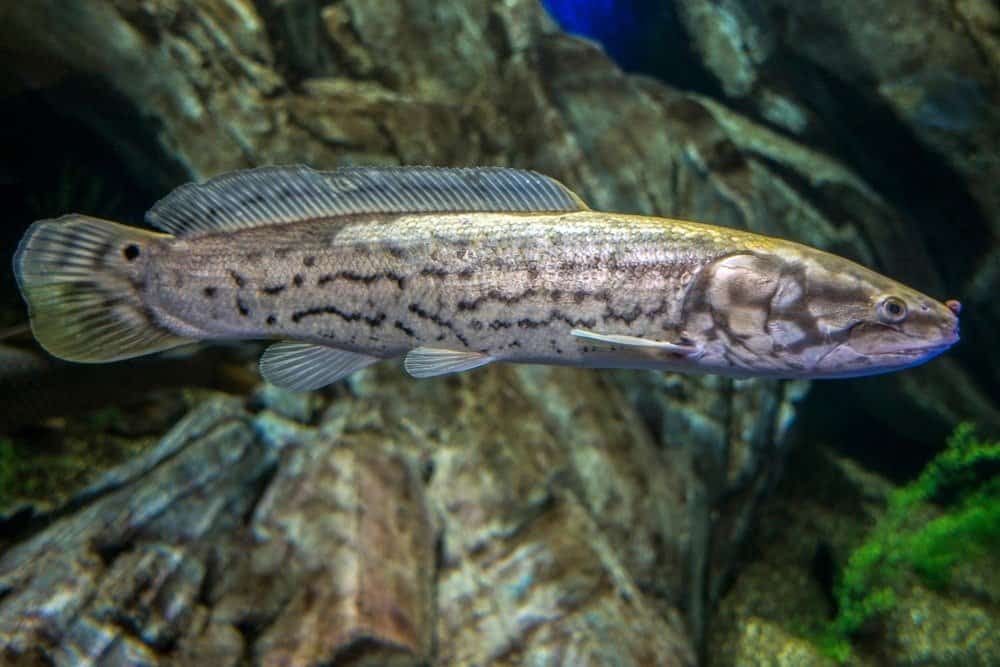At a glance, you may look at the burbot and bowfin and think they are very similar. After all, they are both fish, and most people don’t really see the subtle distinctions between different species of fish.
This is why we will now give you an overview of the burbot vs. bowfin. Once you have read this content, you will be able to distinguish between these two fish species.
It can be helpful to learn to notice seemingly subtle differences between unfamiliar species, as this helps us appreciate just how diverse and complex the animal kingdom truly is in nature.
Comparing Burbot vs. Bowfin

| Burbot | Bowfin | |
|---|---|---|
| Size | 3-5 pounds, with some fish reaching 8 pounds | 1-5 pounds, with some fish going up to 19 pounds |
| Appearance | Mottled skin can be gray, black, olive, or yellow. Flattened head with very small scales. Single whisker at the front, pelvic fins close to the throat and gills, two dorsal fins, long rounded tail. | Brown and olive body with dark blotches for camouflage. No scales on top of the head, no whisker in the front, fins set back from gills, and pectoral fins. Signature black spot next to its tail, short anal fin. |
| Diet | Carnivorous diet. Small ones typically eat insects and zooplankton. Larger ones eat fish. | Carnivorous diet with wide range of prey, including smaller fish, insects, crabs, crayfish, shrimp, salamanders, and more. |
| Habitat | Freshwater habitats in Europe, Asia, and North America. Mostly live in lakes, in addition to large clear and glacial rivers in Alaska. | Freshwater habitats, preference for areas with dense vegetation. Live in rivers, lakes, ponds, streams, swamps, and wetlands. |
| Predators | Many natural predators, including other fish, mink, birds, otters, and humans. | Few natural predators, although juveniles are more vulnerable. Will sometimes fall prey to other fish, alligators, and humans. |
| Geographic Distribution | Bodies of freshwater in the northern hemisphere, throughout Europe, Asia, North America, and possibly the United Kingdom. | Only found in Ontario, Southern Quebec, and the eastern half of the United States. |
Key Differences Between Burbot vs. Bowfin
The key differences between the burbot and the bowfin are size, appearance, diet, and habitat. Other differences include predators and geographic location. The burbot is generally smaller than the bowfin, and there are subtle differences in exterior anatomy as well.
The bowfin also has a wider variety of prey that it captures due to being higher up in the food chain than the burbot. It follows that the burbot has more natural predators as well.
The burbot also has a wider geographic distribution than the bowfin, although the bowfin is less picky about the bodies of water it inhabits.
Let’s look a little harder at these differences now.
Burbot vs. Bowfin: Size

The average weight of the bowfin is between one and five pounds, with some fish reaching up to 19 pounds.
©Clinton & Charles Robertson from RAF Lakenheath, UK & San Marcos, TX, USA & UK / CC BY 2.0 – License
One very significant difference between the burbot and the bowfin is their respective sizes. The bowfin is significantly larger than the burbot.
Though the size of the burbot can vary, the average is between three and five pounds, although some fish can be more than eight pounds. The average weight of the bowfin is between one and five pounds, with some fish reaching up to 19 pounds.
Burbot vs. Bowfin: Appearance
Although people who aren’t fish experts may not readily notice, there are many differences between the appearances of the burbot and bowfin.
The burbot has mottled skin that can be a few different colors, including grey, black, olive, and yellow. The bowfin, in contrast, has a brown and olive body with dark blotches that serve as camouflage for the fish.
The burbot has a flattened head with very small scales in that area, while the bowfin does not have any scales on the top of its head. The burbot also has a single whisker in the very front, as well as pelvic fins that are close to the throat and gills. The bowfin lacks this whisker and has fins that are set back from the gills and pectoral fins.
The burbot has two dorsal fins, which the bowfin lacks. The bowfin also has a signature black spot close to its tail, and the burbot does not. While the burbot has a rounded, somewhat long tail, the bowfin has a short anal fin.
Burbot vs. Bowfin: Diet
The burbot is a carnivore. Small burbots mostly eat insects and zooplankton, while larger burbots go after fish.
The bowfin is also a carnivore, but it has a much wider range of prey compared to the burbot. It’s not picky about what it eats. This fish will eat pretty much anything that can fit into its mouth. This fish will eat smaller fish, insects, crabs, crayfish, shrimp, salamanders, and other animals.
When capturing prey, the bowfin lunges forward and opens its jaws rapidly enough to create a suction, pulling the prey into its mouth.
Burbot vs. Bowfin: Habitat

The bowfin lives in a wider variety of aquatic environments.
©Miroslav Halama/Shutterstock.com
Burbots are likely to live in freshwater habitats in Europe, Asia, and North America. Most of the time, they live in lakes, as well as large clear and glacial rivers throughout Alaska.
The bowfin is somewhat similar in that they tend to live in freshwater habitats. However, the bowfin specifically prefers areas with a vast variety of dense vegetation. They tend to live not only in lakes and rivers, but also ponds, streams, swamps, and wetlands.
The bowfin likes to stay around submerged branches and roots, as well as fallen logs, as these provide them with protection from predators.
Burbot vs. Bowfin: Predators
The burbot has many natural predators, including other fish, even other burbot. The pike also prays on the burbot. Mink, birds, and otters will often eat this fish. Humans often catch this fish as well.
Fewer animals prey on the bowfin, including other bowfins. Juvenile bowfins are much more likely to fall prey to other animals because of their smaller size. Alligators will also prey on these fish when the range overlaps. Humans occasionally capture them as well. However, bowfin do not have many natural predators and are close to the top of the food chain.
Burbot vs. Bowfin: Geographic Distribution

The burbot has many more natural predators than the bowfin; the bowfin is closer to the top of the food chain.
©Rostislav Stefanek/Shutterstock.com
Burbot are distributed in bodies of freshwater throughout Europe, Asia, and North America. They are very widespread, but they are only found in the northern hemisphere. It is possible that this fish is still present in areas of the United Kingdom.
Unlike the burbot, the range of the bowfin is fairly limited. This fish can only be found in Ontario, Southern Quebec, and the eastern half of the United States. At one time, this fish was spread all over Eurasia, Africa, North America, and South America, but this is no longer the case.
The photo featured at the top of this post is © iStock.com/Krugloff
Thank you for reading! Have some feedback for us? Contact the AZ Animals editorial team.






